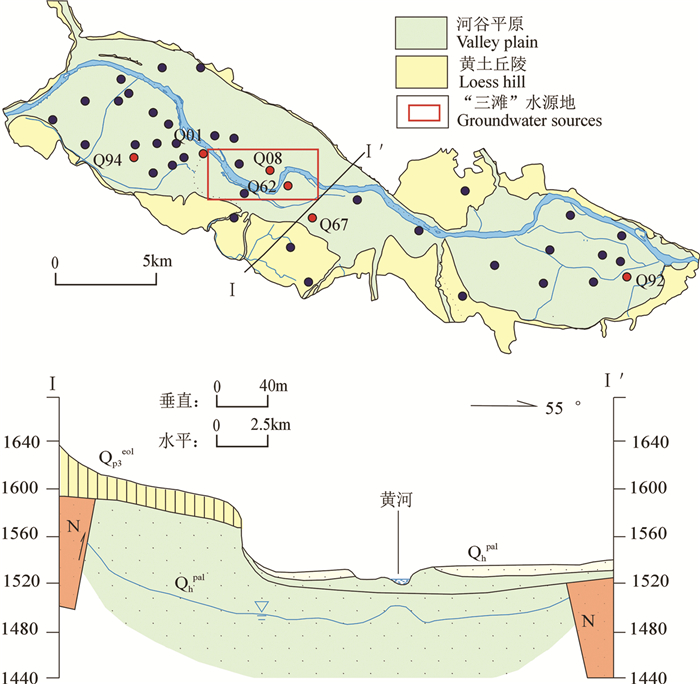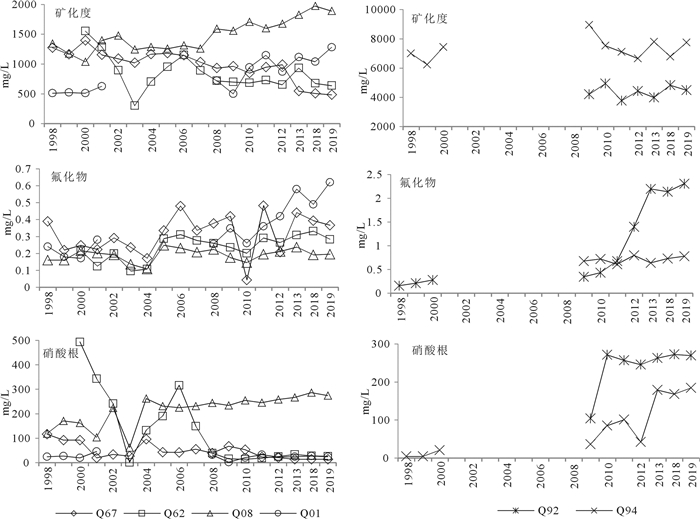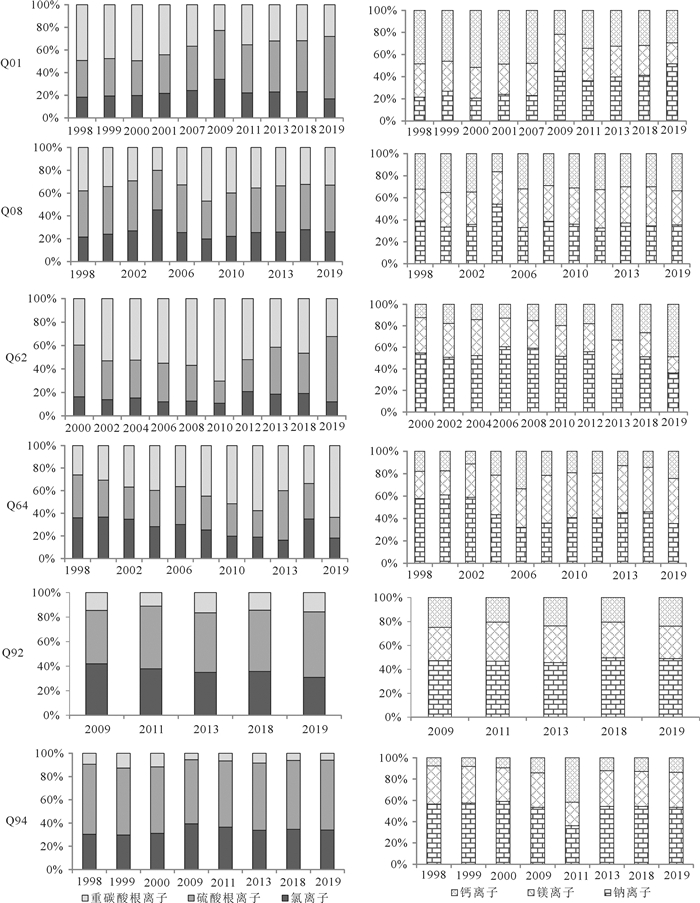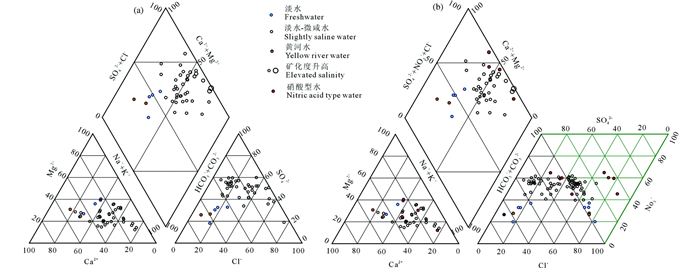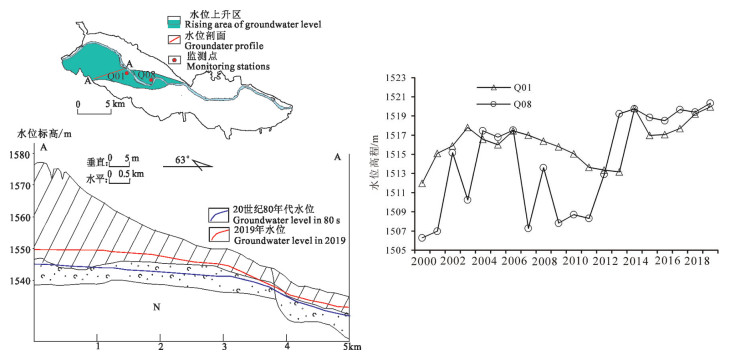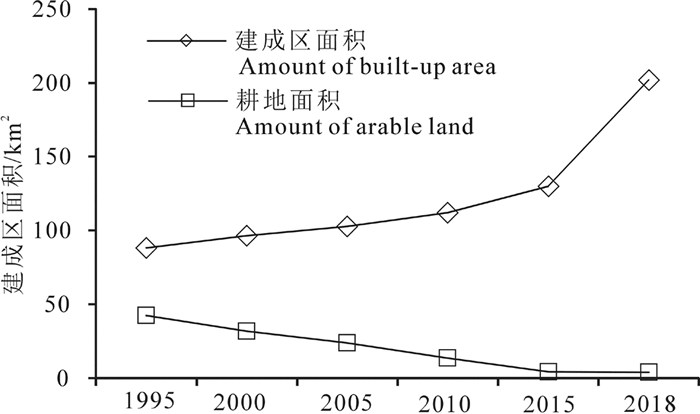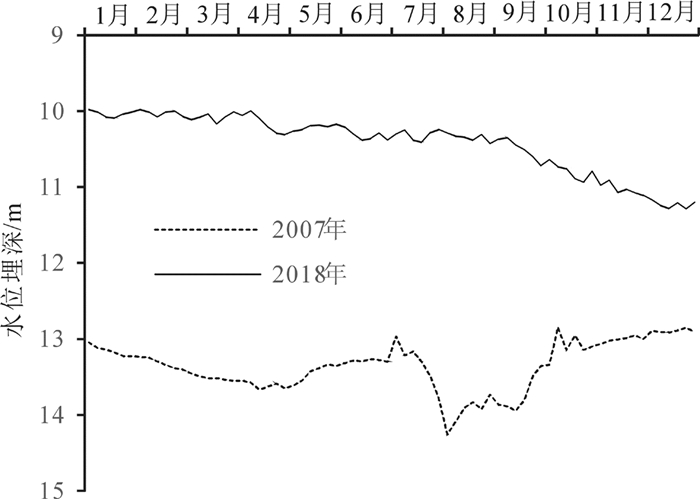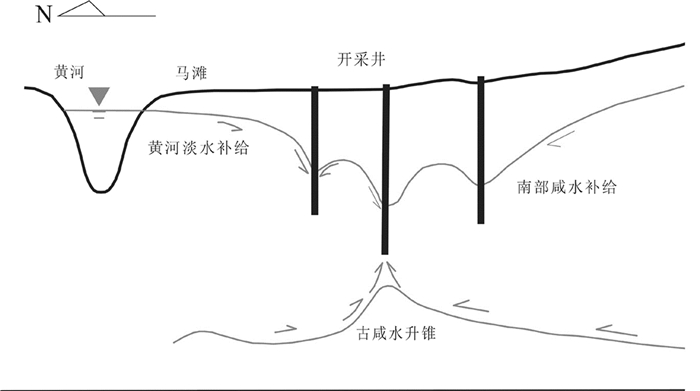-
摘要:
以地下水污染调查数据、地下水监测数据和遥感数据为基础,分析了1998年以来(1998—2019年)兰州不同区域地下水环境变化趋势,探讨了土地利用变化、污染源排放、地下水开采等城市发展要素对地下水的影响。结果表明:1998年以来兰州市地下水环境变化的主要特征是水质恶化、水位上升。溶解性总固体、总硬度、硝酸根、氟等典型水化学指标在大部分地区呈稳定上升趋势,局部地下水中硝酸根比重增加,出现了硝酸型地下水。污染负荷增加是水质恶化的重要驱动因素,且恶化指标与城市主体功能存在直接关系,城关区是主要的居住、商业区,水质恶化的典型指标为硝酸盐;西固区是化工、冶炼等重工业集中区,地下水污染程度最重,反映工业污染的氟化物上升显著;七里河区、安宁区是商业、居住及轻工业的综合分布区,矿化度、总硬度、硝酸根等指标都有不同程度上升,但升幅不大。西固及三滩地区地下水位上升较为明显,其他城区相对稳定,城市不透水界面阻碍了降雨、灌溉等地表垂直入渗,使地下水位年内波动趋于平缓;水源地开采量减少、沿河工程建设以及地下管网渗漏等因素导致地下水补径排条件发生变化,不仅引起城区地下水位上升,还能够增强污染物淋滤和地下水蒸发浓缩,对水化学环境造成一定影响。
Abstract:Based on groundwater pollution survey data, groundwater monitoring data and remote sensing data, the authors analyzed the groundwater environment change trend in different areas of Lanzhou City since the 1990s (1998-2013). The results show that, since 1998, the main groundwater environment change in Lanzhou has been characterized by deterioration of groundwater quality and rising of groundwater level. Typical hydrochemical indexes such as TDS, TH, nitrate and fluorine have different trends in different areas of Lanzhou, and most of them show a steady upward trend. Nitric acid groundwater has appeared in some areas. The increase of urban pollution load is an important driving factor for the rise of typical hydrochemical indicators, and there is a direct relationship between the characteristic indicators and the main functions of different urban areas. Chengguan District is the main residential and commercial area, with the typical index of water quality deterioration being nitrate. Xigu District is a concentrated area of heavy industries such as chemical industry and smelting, with the highest degree of groundwater pollution, and the increase of fluoride suggests that industrial pollution is significant. Qilihe District and Anning District are comprehensive distribution areas of commerce, residence and light industry, and TDS, TH, nitrate and other indicators have all risen in varying degrees, but the increase is not significant. The rise of groundwater level in Xigu and Santan area is more obvious, with that in other areas being relatively stable. Urban impervious interface hinders the vertical infiltration of rainfall, irrigation and other surface water, making the annual fluctuation of groundwater level gentle. Due to the reduction of groundwater exploitation, increasing construction along the Yellow river and the leakage of underground pipe network, the condition of groundwater recharge and discharge is changing. It not only causes the rise of groundwater level in the urban area, but also enhances the leaching of pollutants and the evaporation and concentration of groundwater, which has a certain impact on the hydrochemical environment.
-
Keywords:
- groundwater /
- hydrochemistry /
- hydrodynamic condition /
- urbanization /
- geological survey engineering /
- Lanzhou /
- Gansu Province
-
-
-
Cai Yuemei, Wang Wenxiang, Zhang Mingjiang, Yin Xiulan, Cai Wutian, Wang Ruijiu, Li Wenpeng. 2016. An analysis of the groundwater flow system based on environmental isotopes in Turpan basin[J]. Geology in China, 43(4):1439-1445 (in Chinese with English abstract). http://en.cnki.com.cn/Article_en/CJFDTOTAL-DIZI201604028.htm
E Vázquez-Suñé, X Sánchez-Vila, J Carrera. 2005. Introductory review of specific factors influencing urban groundwater, an emerging branch of hydrogeology, with reference to Barcelona, Spain[J]. Hydrogeology Journal, 13(3):522-533. doi: 10.1007/s10040-004-0360-2
Guo Tongzhang, Wei Xiaoke. 1997. A study of the causes for the deterioration of Lanzhou's groundwater conditions[J]. Journal of Lanzhou Railway University, V(4):32-36 (in Chinese with English abstract). http://en.cnki.com.cn/Article_en/CJFDTotal-LZTX199704005.htm
He Ze, Ning Zhuo, Huang Guanxing, Liu Dandan, Zhang Qianqian, Sun Jichao. 2019. The response characteristics of microbial diversity to shallow groundwater contamination in the piedmont of the Taihang Mountains using molecular biotechnologies:A case study of groundwater of Hutuo River Basin[J]. Geology in China, 46(2):78-89 (in Chinese with English abstract) http://en.cnki.com.cn/Article_en/CJFDTotal-DIZI201902007.htm
Li Tao, Ma Teng, Li Liang, Zuo Mingfang. 2010. An analysis of groundwater quality evolution in the area of depression cone in the Santan riverside wellfield[J]. Hydrogeology & Engineering Geology, 37(2):10-15 (in Chinese with English abstract). http://en.cnki.com.cn/Article_en/CJFDTOTAL-SWDG201002007.htm
Li Jianhong. 2019. Study on hydrogeological characteristics of groundwater in Lanzhou City[J]. Urban Roads Bridges & Flood Control, 8:155-157, 20-21 (in Chinese with English abstract). http://en.cnki.com.cn/Article_en/CJFDTotal-BASE2019S1025.htm
Li Zhenghong, Zhang Yilong, Hu Bo, Wang Lijuan, Zhu Yuchen, Li Jianfeng. 2018. Driving action of human activities on NO3--N pollution in confined groundwater of Togtoh County, Inner Mongolia[J]. Acta Geoscientica Sinica, 39(2):358-364 (in Chinese with English abstract). http://www.zhangqiaokeyan.com/academic-journal-cn_acta-geoscientica-sinica_thesis/0201253090763.html
Liao Lei, Hen Jiangtao, Ceng Ying, Peng Cong, Huang De Liang. 2016. A study of nitrate background level of shollow groundwater in the Liujiang Basin[J]. Geology in China, 43(2):671-682 (in Chinese with English abstract). http://www.cnki.com.cn/Article/CJFDTotal-DIZI201602026.htm
Ling Mingge, Liu Fang, Zhu Jian, Zhang Qiaoxiang. 2012. Influence of urbanization on concentrations of N and P in shallow groundwater and its evaluation in karst hilly area of Guizhou Province[J]. Bulletin of Soil and Water Conservation, 32(5):141-144 (in Chinese with English abstract). http://search.cnki.net/down/default.aspx?filename=STTB201205030&dbcode=CJFD&year=2012&dflag=pdfdown
Liu Shan, Li Hongwei, Jin Xiaowen, Li Yanni. 2018. Research on the environmental impact of backfilling under dewatering mine conditions[J]. Hydrogeology & Engineering Geology, 45(6):62-68 (in Chinese with English abstract). http://en.cnki.com.cn/Article_en/CJFDTotal-HHGZ201801014.htm
Lü Xiaoli, Sun Jichao, Liu Jingtao, Jin Shenghai, Cui Haiwei, Zhang Ying. 2014. Evolution and countermeasures of water quality of the Santan wellfield in Lanzhou based on GMS[J]. Hydrogeology & Engineering Geology, 41(4):24-31 (in Chinese with English abstract). http://en.cnki.com.cn/Article_en/CJFDTotal-SWDG201404009.htm
Lü Xiaoli, Sun Jichao, Liu Jingtao, Jin Shenghai, Zhang Yuxi. 2015.The influence of the groundwater pollution on a riverside source field[J]. Geological Bulletin of China, 34(5):983-989 (in Chinese with English abstract). http://www.researchgate.net/publication/282985347_The_influence_of_the_groundwater_pollution_on_a_riverside_source_field
Lü Xiaoli, Liu Jingtao, Zhu Liang, Liu Chunyan, Liu Junjian. 2019.Distribution and source of nitrogen pollution in groundwater of Lanzhou City[J]. Journal of Arid Land Resources and Environment, 33(1):95-100 (in Chinese with English abstract). http://en.cnki.com.cn/Article_en/CJFDTotal-GHZH201901015.htm
Lü Xiaoli, Liu Jingtao, Zhu Liang, Liu Junjian, Liu Chunyan. 2019.Distribution and source of Fe and Mn in groundwater of Lanzhou City[J]. Journal of Arid Land Resources and Environment, 33(3):132-138 (in Chinese with English abstract). http://en.cnki.com.cn/Article_en/CJFDTotal-GHZH201901015.htm
Manish Kumar, M.Someshwar Rao, Bhishm Kumar, Algappan Ramanathan. 2011. Identification of aquifer-recharge zones and sources in an urban development area (Delhi, India), by correlating isotopic tracers with hydrological features[J]. Hydrogeology Journal, 19(2):463-474. doi: 10.1007/s10040-010-0692-z
Sun Houyun, Mao Qigui, Wei Xiaofeng, Zhang Huiqiong, Xi Yuze. 2018. Hydrogeochemical characteristics and formation evolutionary mechanism of the groundwater system in the Hami basin[J]. Geology in China, 45(6):1128-1141 (in Chinese with English abstract). http://en.cnki.com.cn/Article_en/CJFDTotal-DIZI201806005.htm
Wang Xiaoyong, Zhu Lifeng, Dong Jiaqiu, Zhang Jun, Yin Lihe. 2019.Influence of underlying surface change on hydrogeological conditions in arid and semi-arid regions[J]. Northwesten Geology, 52(2):227-235 (in Chinese with English abstract). http://www.zhangqiaokeyan.com/academic-journal-cn_northwestern-geology_thesis/0201272955603.html
Wu Bin, Wang Sai, Wang Wenxiang, An Yonghui. 2019. Impact of future climate change on water resources in the arid regions of Northwest China based on surface water-groundwater coupling model:A case study of the middle reaches of the Heihe River[J]. Geology in China, 46(02):157-168 (in Chinese with English abstract).
Xiao Xiang. 2011. A historical analysis of China's urbanization and evolution of Industrial structure (1949-2010)[J]. Teaching and Research, 6:18-25 (in Chinese with English abstract). http://en.cnki.com.cn/Article_en/CJFDTOTAL-JWDP201106002.htm
Yan Baizhong, Xiao Changlai, Liu Hongzhi, Wei Runchu Liang Xiujuan. 2015. Effect of urban land use on the spatial distribution of groundwater pollution in the Jilin City[J]. China Environmental Science, V(3):934-942 (in Chinese with English abstract).
Yang Lei, Gong Xulong, Lu Xurong, Zhang Yan. 2015. Distribution and genesis of high-fluoride groundwater in northern Lianyungang area[J]. Geology in China, 42(4):1161-1169 (in Chinese with English abstract). http://www.cnki.com.cn/Article/CJFDTotal-DIZI201504029.htm
Yu Kaining, Lou Huajun, Guo Zhenzhong, Li Tao. 2004. Mechanism of groundwater recharge increment induced by urbanization[J]. Resources Science, 26(2):68-73 (in Chinese with English abstract). http://en.cnki.com.cn/Article_en/CJFDTOTAL-ZRZY200402010.htm
Yu Zhenguo, Yanggu, Lianyanqing. 1992. The study of formation process and circulation of groundwater source of vicinity along the both said of the river in Lanzhou with H, O isotope change[J]. Acta Geologica Gansu, V(1):68-84 (in Chinese with English abstract). http://en.cnki.com.cn/Article_en/CJFDTotal-GSDZ199201007.htm
Yuan Jianfei, Deng Guoshi, Xufen Tang Yueqi, Li Pengyu. 2016. The multivariate statistical analysis of chemical characteristics and influencing factors of karst groundwater in the northern part of Bijie City, Guizhou Province[J]. Geology in China, 43(4):1446-1456 (in Chinese with English abstract). http://en.cnki.com.cn/Article_en/CJFDTotal-DIZI201604029.htm
Zhang Maosheng, Wang Huaqi, Wang Rao, Dong Ying, Sun Pingping. 2018. Progress and Prospect of Urban Geological Survey in China[J]. Northwestern Geology, 51(4):5-13 (in Chinese with English abstract). http://www.zhangqiaokeyan.com/academic-journal-cn_northwestern-geology_thesis/0201270250733.html
Zhang Mingquan, Gao Hongxuan, Wu Kejian. 1990. A survey on the cause of nitric radical NO3- pollution in water-supply, source site of Lanzhou City[J]. Environmental Science, V(5):79-82 (in Chinese with English abstract). http://www.jourlib.org/paper/1583082
Zhang Xiaowen, He Jiangtao, Liu Dandan, Ni Zehua, Zhang Changyan. 2018. An analysis of the stress effects and methods of the shallow groundwater quality in the Hutuo River alluvial fan[J]. Hydrogeology & Engineering Geology, 45(5):54-62 (in Chinese with English abstract). http://search.cnki.net/down/default.aspx?filename=SWDG201805007&dbcode=CJFD&year=2018&dflag=pdfdown
Zhang Zhibin, Gong Weimin, Zhang Huailin, Wang Kaijia, Zhao Hang. 2019.The Spatial agglomeration characteristics and its influencing factors of producer services in Lanzhou[J]. Economic Geography, 39(9):112-121 (in Chinese with English abstract). http://en.cnki.com.cn/Article_en/CJFDTotal-JJDL201909015.htm
Zhou Xun, Ye Yonghong. 2014. Improvement and application of Schukalev groundwater hydrochemical classification method:Taking groundwaters in Jinjiang City, Fujian Province as an example[J]. Resources Survey and Environment, 35(4):299-304(in Chinese with English abstract). http://en.cnki.com.cn/Article_en/CJFDTOTAL-HSDZ201404010.htm
Zhu Liang, Sun Jichao, Liu Jingtao, Liu Junjian, Lü Xiaoli. 2014.Effect of urbanizition on groundwater system in Lanzhou[J]. Journal of Water Resources & Water Engineering, V(3):111-115(in Chinese with English abstract). http://or.nsfc.gov.cn/handle/00001903-5/458434
Zhu Liang, Yang Mingnan, Chen Xi, Liu Jingtao. 2019. Health Risk Assessment and Risk Control:Drinking Groundwater in Yinchuan Plain, China[J]. Exposure & Health, 11(1):59-72. doi: 10.1007/s12403-017-0266-6
蔡月梅, 王文祥, 张明江, 张明江, 殷秀兰, 蔡五田, 王瑞久, 李文鹏. 2016.基于环境同位素分析吐鲁番盆地地下水流系统[J].中国地质, 43(4):1439-1445. http://geochina.cgs.gov.cn/geochina/ch/reader/view_abstract.aspx?file_no=20160427&flag=1 郭同章, 魏肖克. 1997.兰州市地下水环境恶化的原因探析[J].兰州交通大学学报, (4):32-36. http://www.cqvip.com/QK/90525X/199704/2849691.html 何泽, 宁卓, 黄冠星, 刘丹丹, 张千千, 孙继朝. 2019.太行山前平原浅层地下水污染的分子生物学响应特征——以滹沱河流域为例[J].中国地质, 46(2):78-89. http://geochina.cgs.gov.cn/geochina/ch/reader/view_abstract.aspx?file_no=20190206&flag=1 黎涛, 马腾, 李亮, 左鸣放. 2010."三滩"傍河水源地地下水水位降落漏斗区水质演化[J].水文地质工程地质, 37(2):10-15. http://d.wanfangdata.com.cn/Periodical/swdzgcdz201002004 李建宏. 2019.兰州市城区地下水水文地质特征研究[J].城市道桥与防洪, (8):155-157, 20-21 http://www.cnki.com.cn/Article/CJFDTotal-CSDQ201908056.htm 李政红, 张翼龙, 胡波, 王丽娟, 朱玉晨, 李剑锋. 2018.人类活动对内蒙古托克托县浅层地下水NO3-N污染的驱动作用[J].地球学报, 39(3):358-364. http://d.old.wanfangdata.com.cn/Periodical/dqxb201803010 廖磊, 何江涛, 曾颖, 彭聪, 黄德亮. 2016.柳江盆地浅层地下水硝酸盐背景值研究[J].中国地质, 43(2):671-682. http://geochina.cgs.gov.cn/geochina/ch/reader/view_abstract.aspx?file_no=20160226&flag=1 凌明阁, 刘方, 朱健, 张巧香. 2012.贵州省中部喀斯特山区城镇化对浅层地下水氮磷的影响及评价[J].水土保持通报, 32, 141-144. http://d.wanfangdata.com.cn/Periodical/stbctb201205029 柳山, 李洪伟, 金晓文, 李燕妮. 2018.疏干降水条件下矿渣回填对地下水环境的影响研究[J].水文地质工程地质, 45(6):62-68. http://www.cnki.com.cn/Article/CJFDTotal-SWDG201806009.htm 吕晓立, 孙继朝, 刘景涛, 靳盛海, 崔海炜, 张英. 2014.基于GMS的兰州"三滩"水源地地下水水质演化及调控对策[J].水文地质工程地质, 41(4):24-31. http://www.cnki.com.cn/Article/CJFDTotal-SWDG201404009.htm 吕晓立, 孙继朝, 刘景涛, 靳盛海, 张玉玺. 2015.地下水污染羽对傍河水源地的影响[J].地质通报, 34(5):983-989. http://www.cnki.com.cn/Article/CJFDTotal-ZQYD201505018.htm 吕晓立, 刘景涛, 朱亮, 刘春燕, 刘俊建. 2019.兰州市地下水中"三氮"污染特征及成因[J].干旱区资源与环境, 33(01):95-100. http://www.cnki.com.cn/Article/CJFDTotal-GHZH201901015.htm 吕晓立, 刘景涛, 朱亮, 刘俊建, 刘春燕. 2019.兰州市地下水中铁锰分布特征及成因[J].干旱区资源与环境, 33(03):132-138. http://www.cnki.com.cn/Article/CJFDTotal-GHZH201903022.htm 孙厚云, 毛启贵, 卫晓锋, 张会琼, 葸玉泽. 2018.哈密盆地地下水系统水化学特征及形成演化[J].中国地质, 45(6):1128-1141. http://geochina.cgs.gov.cn/geochina/ch/reader/view_abstract.aspx?file_no=20180604&flag=1 王晓勇, 朱立峰, 董佳秋, 张俊, 尹立河. 2019.干旱-半干旱区下垫面变化对地下水位的影响[J].西北地质, 52(2):227-235 http://www.cnki.com.cn/Article/CJFDTotal-XBDI201902028.htm 吴斌, 王赛, 王文祥, 安永会. 2019.基于地表水-地下水耦合模型的未来气候变化对西北干旱区水资源影响研究——以黑河中游为例[J].中国地质, 46(2):157-168. http://geochina.cgs.gov.cn/geochina/ch/reader/view_abstract.aspx?file_no=20190213&flag=1 肖翔. 2011.中国城市化与产业结构演变的历史分析(1949-2010)[J].教学与研究, (6):18-25. http://www.cnki.com.cn/Article/CJFDTotal-JWDP201106002.htm 闫佰忠, 肖长来, 刘泓志, 危润初, 梁秀娟. 2015.吉林市城区土地利用对地下水污染空间分布的影响[J].中国环境科学, (3):934-942. http://www.cnki.com.cn/Article/CJFDTotal-ZGHJ201503050.htm 杨磊, 龚绪龙, 陆徐荣, 张岩. 2015.连云港北部地区高氟地下水分布特征及成因[J].中国地质, 42(4):1161-1169. http://geochina.cgs.gov.cn/geochina/ch/reader/view_abstract.aspx?file_no=20150429&flag=1 于开宁, 娄华君, 郭振中, 李涛. 2004.城市化诱发地下水补给增量的机理分析[J].资源科学, 26(2):68-73. http://www.cnki.com.cn/Article/CJFDTotal-ZRZY200402010.htm 余振国, 杨顾, 连炎清. 1992.应用氢氧同位素方法研究兰州市傍河水源地地下水水体的形成和循环机理[J].甘肃地质, 1992, (1):68-84. http://www.cnki.com.cn/Article/CJFDTotal-GSDZ199201007.htm 袁建飞, 邓国仕, 徐芬, 唐业旗, 李鹏岳. 2016.毕节市北部岩溶地下水水化学特征及影响因素的多元统计分析[J].中国地质, 43(4):1446-1456. http://geochina.cgs.gov.cn/geochina/ch/reader/view_abstract.aspx?file_no=20160428&flag=1 张茂省, 王化齐, 王尧, 董英, 孙萍萍. 2018.中国城市地质调查进展与展望[J].西北地质, 51(4):5-13. http://d.wanfangdata.com.cn/periodical/xbdz201804001 张明泉, 高洪宣, 吴克俭. 1990.兰州马滩水源地NO3-污染环境条件分析[J].环境科学, (5):79-82. http://www.cnki.com.cn/Article/CJFDTotal-HJKZ199005022.htm 张小文, 何江涛, 刘丹丹, 倪泽华, 张昌延. 2018.滹沱河冲洪积扇浅层地下水水质外界胁迫作用分析[J].水文地质工程地质, 45(5):54-62. http://d.old.wanfangdata.com.cn/Periodical/swdzgcdz201805007 张志斌, 公维民, 张怀林, 王凯佳, 赵航. 2019.兰州市生产性服务业的空间集聚及其影响因素[J].经济地理, 39(9):112-121. http://www.cnki.com.cn/Article/CJFDTotal-JJDL201909015.htm 周迅, 叶永红2014.地下水舒卡列夫水化学分类法的改进及应用——以福建省晋江市地下水为例[J].华东地质, 35(4):299-304. http://www.cqvip.com/QK/95903B/201404/663292147.html 朱亮, 孙继朝, 刘景涛, 刘俊建, 吕晓立. 2014.兰州市城市化对地下水系统的影响研究[J].水资源与水工程学报, (3):111-115. http://d.wanfangdata.com.cn/Periodical/xbszyysgc201403022 -
期刊类型引用(11)
1. Jian-yu Liu,Hong-feng Nie,Liang Xu,Chun-lei Xiao,Wei Li,Guo-li Yuan,Yan-peng Huang,Xin-yang Ji,Tian-qi Li. Assessment of ecological geological vulnerability in Mu Us Sandy Land based on GIS and suggestions of ecological protection and restoration. China Geology. 2025(01): 117-143 .  必应学术
必应学术
2. 祝晓松,裴小龙,王伟,张中跃,孙伟涛,倪舒博,公为鑫. 山丘区地表基质空间异质性特征及其对植被生态影响. 地质通报. 2024(09): 1544-1554 .  百度学术
百度学术
3. 刘洪,李文昌,欧阳渊,张景华,张腾蛟,李佑国,黄瀚霄,黄勇,李富,陈敏华,李樋,吴君毅. 基于地质建造的西南山区生态地质编图探索与实践——以邛海—泸山地区为例. 地质学报. 2023(02): 623-638 .  百度学术
百度学术
4. 息朝庄,吴林锋,张鹏飞,杨茗钛,范云飞,夏浩东,邓会娟. 贵州省惠水土壤-灌溉水-雨水-大气降尘中Cd、As等微量元素特征及来源讨论. 中国地质. 2023(01): 192-205 .  本站查看
本站查看
5. 王东晓,袁德志. 锶在土壤-作物中迁移富集机制及作物富锶标准探讨:以河南固始史河一带为例. 现代地质. 2023(03): 767-777 .  百度学术
百度学术
6. 唐智明. 水肥一体化技术及其在柑橘种植上的应用. 现代农业科技. 2022(01): 73-75 .  百度学术
百度学术
7. 习文勇,傅佩红. 基于模糊数学的柑橘种植土地适宜性评价. 浙江农业学报. 2022(01): 141-152 .  百度学术
百度学术
8. 张哲寰,杨佳佳,宋运红,贺鹏飞. 黑龙江省讷河市土壤质量与绿色产地适宜性评价. 地质与资源. 2022(02): 183-192 .  百度学术
百度学术
9. 贾磊,刘洪,欧阳渊,张伟,窦磊,刘子宁,莫滨,陈恩,张腾蛟. 基于地质建造的南方山地-丘陵区地表基质填图单元划分方案——以珠三角新会—台山地区为例. 西北地质. 2022(04): 140-157 .  百度学术
百度学术
10. 李海山. 柑橘种植与机械化节水灌溉技术探讨. 农业开发与装备. 2021(10): 225-226 .  百度学术
百度学术
11. 欧阳渊,张景华,刘洪,黄瀚霄,张腾蛟,黄勇. 基于地质建造的西南山区成土母质分类方案——以大凉山区为例. 中国地质调查. 2021(06): 50-62 .  百度学术
百度学术
其他类型引用(4)




 下载:
下载:
